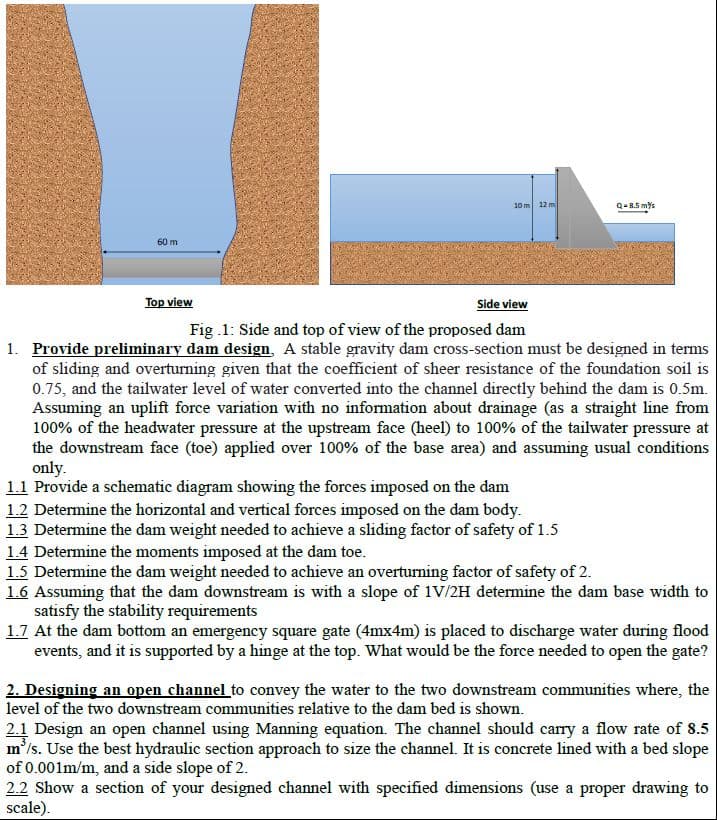10m 12 m Q-85 ms 60 m Top view Side view Fig .1: Side and top of view of the proposed dam 1. Provide preliminary dam design. A stable gravity dam cross-section must be designed in terms of sliding and overtuming given that the coefficient of sheer resistance of the foundation soil is 0.75, and the tailwater level of water converted into the channel directly behind the dam is 0.5m. Assuming an uplift force variation with no information about drainage (as a straight line from 100% of the headwater pressure at the upstream face (heel) to 100% of the tailwater pressure at the downstream face (toe) applied over 100% of the base area) and assuming usual conditions only. 1.1 Provide a schematic diagram showing the forces imposed on the dam 1.2 Determine the horizontal and vertical forces imposed on the dam body.. 1.3 Determine the dam weight needed to achieve a sliding factor of safety of 1.5
10m 12 m Q-85 ms 60 m Top view Side view Fig .1: Side and top of view of the proposed dam 1. Provide preliminary dam design. A stable gravity dam cross-section must be designed in terms of sliding and overtuming given that the coefficient of sheer resistance of the foundation soil is 0.75, and the tailwater level of water converted into the channel directly behind the dam is 0.5m. Assuming an uplift force variation with no information about drainage (as a straight line from 100% of the headwater pressure at the upstream face (heel) to 100% of the tailwater pressure at the downstream face (toe) applied over 100% of the base area) and assuming usual conditions only. 1.1 Provide a schematic diagram showing the forces imposed on the dam 1.2 Determine the horizontal and vertical forces imposed on the dam body.. 1.3 Determine the dam weight needed to achieve a sliding factor of safety of 1.5
Principles of Geotechnical Engineering (MindTap Course List)
9th Edition
ISBN:9781305970939
Author:Braja M. Das, Khaled Sobhan
Publisher:Braja M. Das, Khaled Sobhan
Chapter15: Slope Stability
Section: Chapter Questions
Problem 15.16P
Related questions
Question
Scenario:
As a Hydraulic Engineer you are required to design a dam to create a reservoir in Amman City, open
channel and pumps to convey water from the reservoir to a downstream community, and a pipe
network to distribute the water within the community. Based on the hydrology assessment of the
watershed the dam height was set to 12 m above ground level, with a freeboard of 2m (water level in
the dam is 10m), dam width of 60m, and downstream flow was set at 8.5 m3/s (see Fig.1 below). Your
task as an engineer is to provide a water supply for a planned community. Your project will involve (as a minimum):

Transcribed Image Text:10 m 12 m
Q-8.5 mys
60 m
Top view
Side view
Fig .1: Side and top of view of the proposed dam
1. Provide preliminary dam design, A stable gravity dam cross-section must be designed in terms
of sliding and overturning given that the coefficient of sheer resistance of the foundation soil is
0.75, and the tailwater level of water converted into the channel directly behind the dam is 0.5m.
Assuming an uplift force variation with no information about drainage (as a straight line from
100% of the headwater pressure at the upstream face (heel) to 100% of the tailwater pressure at
the downstream face (toe) applied over 100% of the base area) and assuming usual conditions
only.
1.1 Provide a schematic diagram showing the forces imposed on the dam
1.2 Determine the horizontal and vertical forces imposed on the dam body.
1.3 Determine the dam weight needed to achieve a sliding factor of safety of 1.5
1.4 Determine the moments imposed at the dam toe.
1.5 Determine the dam weight needed to achieve an overturning factor of safety of 2.
1.6 Assuming that the dam downstream is with a slope of 1V/2H determine the dam base width to
satisfy the stability requirements
1.7 At the dam bottom an emergency square gate (4mx4m) is placed to discharge water during flood
events, and it is supported by a hinge at the top. What would be the force needed to open the gate?
2. Designing an open channel to convey the water to the two downstream communities where, the
level of the two downstream communities relative to the dam bed is shown.
2.1 Design an open channel using Manning equation. The channel should carry a flow rate of 8.5
m'/s. Use the best hydraulic section approach to size the channel. It is concrete lined with a bed slope
of 0.001m/m, and a side slope of 2.
2.2 Show a section of your designed channel with specified dimensions (use a proper drawing to
scale).
Expert Solution
This question has been solved!
Explore an expertly crafted, step-by-step solution for a thorough understanding of key concepts.
Step by step
Solved in 3 steps with 1 images

Knowledge Booster
Learn more about
Need a deep-dive on the concept behind this application? Look no further. Learn more about this topic, civil-engineering and related others by exploring similar questions and additional content below.Recommended textbooks for you

Principles of Geotechnical Engineering (MindTap C…
Civil Engineering
ISBN:
9781305970939
Author:
Braja M. Das, Khaled Sobhan
Publisher:
Cengage Learning

Principles of Geotechnical Engineering (MindTap C…
Civil Engineering
ISBN:
9781305970939
Author:
Braja M. Das, Khaled Sobhan
Publisher:
Cengage Learning